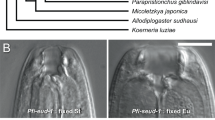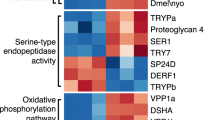Abstract
Nutrition-responsive development is a ubiquitous and highly diversified example of phenotypic plasticity, yet its underlying molecular and developmental mechanisms and modes of evolutionary diversification remain poorly understood. We measured genome-wide transcription in three closely related species of horned beetles exhibiting strikingly diverse degrees of nutrition responsiveness in the development of male weaponry. We show that (1) counts of differentially expressed genes between low- and high-nutritional backgrounds mirror species-specific degrees of morphological nutrition responsiveness; (2) evolutionary exaggeration of morphological responsiveness is underlain by both amplification of ancestral nutrition-responsive gene expression and recruitment of formerly low nutritionally responsive genes; and (3) secondary loss of morphological responsiveness to nutrition coincides with a dramatic reduction in gene expression plasticity. Our results further implicate genetic accommodation of ancestrally high variability of gene expression plasticity in both exaggeration and loss of nutritional plasticity, yet reject a major role of taxon-restricted genes in the developmental regulation and evolution of nutritional plasticity.
This is a preview of subscription content, access via your institution
Access options
Access Nature and 54 other Nature Portfolio journals
Get Nature+, our best-value online-access subscription
$29.99 / 30 days
cancel any time
Subscribe to this journal
Receive 12 digital issues and online access to articles
$119.00 per year
only $9.92 per issue
Buy this article
- Purchase on Springer Link
- Instant access to full article PDF
Prices may be subject to local taxes which are calculated during checkout





Similar content being viewed by others
Data availability
All data are available through NCBI’s Short Read Archive (BioProject accession: PRJNA608082).
References
Beldade, P., Mateus, A. R. & Keller, R. Evolution and molecular mechanisms of adaptive developmental plasticity. Mol. Ecol. 20, 1347–1363 (2011).
West-Eberhard, M. J. Developmental Plasticity and Evolution (Oxford Univ. Press, 2003).
Koyama, T., Mendes, C. C. & Mirth, C. K. Mechanisms regulating nutrition-dependent developmental plasticity through organ-specific effects in insects. Front. Physiol. 4, 263 (2013).
Gotoh, H. et al. Developmental link between sex and nutrition; doublesex regulates sex-specific mandible growth via juvenile hormone signaling in stag beetles. PLoS Genet. 10, e1004098 (2014).
Koyama, T. & Mirth, C. K. Unravelling the diversity of mechanisms through which nutrition regulates body size in insects. Curr. Opin. Insect Sci. 25, 1–8 (2018).
Mirth, C. K. & Shingleton, A. W. Integrating body and organ size in Drosophila: recent advances and outstanding problems. Front. Endocrinol. 3, 49 (2012).
Emlen, D. J., Warren, I. A., Johns, A., Dworkin, I. & Lavine, L. C. A mechanism of extreme growth and reliable signaling in sexually selected ornaments and weapons. Science 337, 860–864 (2012).
Casasa, S. & Moczek, A. P. Insulin signalling’s role in mediating tissue-specific nutritional plasticity and robustness in the horn-polyphenic beetle Onthophagus taurus. Proc. R. Soc. Lond. B 285, 20181631 (2018).
Xu, H. J. et al. Two insulin receptors determine alternative wing morphs in planthoppers. Nature 519, 464–467 (2015).
Fawcett, M. M. et al. Manipulation of insulin signaling phenocopies evolution of a host-associated polyphenism. Nat. Commun. 9, 1699 (2018).
Kijimoto, T., Moczek, A. P. & Andrews, J. Diversification of doublesex function underlies morph-, sex-, and species-specific development of beetle horns. Proc. Natl Acad. Sci. USA 109, 20526–20531 (2012).
Kijimoto, T. & Moczek, A. P. Hedgehog signaling enables nutrition-responsive inhibition of an alternative morph in a polyphenic beetle. Proc. Natl Acad. Sci. USA 113, 5982–5987 (2016).
Snell-Rood, E. C. et al. Developmental decoupling of alternative phenotypes: insights from the transcriptomes of horn-polyphenic beetles. Evolution 65, 231–245 (2011).
Kijimoto, T. et al. The nutritionally responsive transcriptome of the polyphenic beetle Onthophagus taurus and the importance of sexual dimorphism and body region. Proc. R. Soc. Lond. B 281, 20142084 (2014).
Klasberg, S., Bitard-Feildel, T. & Mallet, L. Computational identification of novel genes: current and future perspectives. Bioinform. Biol. Insights 10, 121–131 (2016).
Santos, M. E., Le Bouquin, A., Crumière, A. J. J. & Khila, A. Taxon-restricted genes at the origin of a novel trait allowing access to a new environment. Science 358, 386–390 (2017).
Pfennig, D. W. et al. Phenotypic plasticity’s impacts on diversification and speciation. Trends Ecol. Evol. 25, 459–467 (2010).
Moczek, A. P. et al. The role of developmental plasticity in evolutionary innovation. Proc. R. Soc. Lond. B 278, 2705–2713 (2011).
Wund, M. A. Assessing the impacts of phenotypic plasticity on evolution. Integr. Comp. Biol. 52, 5–15 (2012).
Levis, N. A. & Pfennig, D. W. Evaluating ‘plasticity-first’ evolution in nature: key criteria and empirical approaches. Trends Ecol. Evol. 31, 563e574 (2016).
Suzuki, Y. & Nijhout, H. F. Evolution of a polyphenism by genetic accommodation. Science 311, 650–652 (2006).
Ledón-Rettig, C. C., Pfennig, D. W. & Nascone-Yoder, N. Ancestral variation and the potential for genetic accommodation in larval amphibians: implications for the evolution of novel feeding strategies. Evol. Dev. 10, 316–325 (2008).
Scoville, A. G. & Pfrender, M. E. Phenotypic plasticity facilitates recurrent rapid adaptation to introduced predators. Proc. Natl Acad. Sci. USA 107, 4260–4263 (2010).
Sikkink, K. L., Reynolds, R. M., Ituarte, C. M., Cresko, W. & Phillips, P. C. Rapid evolution of phenotypic plasticity and shifting thresholds of genetic assimilation in the nematode Caenorhabditis remanei. G3 4, 1103–1112 (2014).
Susoy, V., Ragsdale, E. J., Kanzaki, N. & Sommer, R. J. Rapid diversification associated with a macroevolutionary pulse of developmental plasticity. eLife 4, e05463 (2015).
Walworth, N. G., Lee, M. D., Fu, F.-X., Hutchins, D. A. & Webb, E. A. Molecular and physiological evidence of genetic assimilation to high CO2 in the marine nitrogen fixer Trichodesmium. Proc. Natl Acad. Sci. USA 113, E7367–E7374 (2016).
Badyaev, A. V., Potticary, A. L. & Morrison, E. S. Most colorful example of genetic assimilation? Exploring the evolutionary destiny of recurrent phenotypic accommodation. Am. Nat. 190, 266–280 (2017).
Kulkarni, S. S., Denver, R. J., Gomez-Mestre, I. & Buchholz, D. R. Genetic accommodation via modified endocrine signalling explains phenotypic divergence among spadefoot toad species. Nat. Commun. 8, 993 (2017).
Levis, N. A., Isdaner, A. J. & Pfennig, D. W. Morphological novelty emerges from pre-existing phenotypic plasticity. Nat. Ecol. Evol. 2, 1289–1297 (2018).
Levis, N. A., Serrato-Capuchina, A. & Pfennig, D. W. Genetic accommodation in the wild: evolution of gene expression plasticity during character displacement. J. Evol. Biol. 30, 1712–1723 (2017).
Renn, S. C. P. & Schummer, M. E. Genetic accommodation and behavioural evolution: insights from genomic studies. Anim. Behav. 85, 1012–1022 (2013).
Génier, F. & Moretto, P. Digitonthophagus Balthasar, 1959: taxonomy, systematics, and morphological phylogeny of the genus revealing an African species complex (Coleoptera: Scarabaeidae: Scarabaeinae). Zootaxa 4248, 1–110 (2017).
Emlen, D. J., Hunt, J. & Simmons, L. W. Evolution of sexual dimorphism and male dimorphism in the expression of beetle horns: phylogenetic evidence for modularity, evolutionary lability, and constraint. Am. Nat. 166, S42–S68 (2005).
Nourmohammad, A. et al. Adaptive evolution of gene expression in Drosophila. Cell Rep. 20, 1385–1395 (2017).
Signor, S. A. & Nuzhdin, S. V. The evolution of gene expression in cis and trans. Trends Genet. 34, 532–544 (2018).
Zdobnov, E. M. et al. OrthoDB v9.1: cataloging evolutionary and functional annotations for animal, fungal, plant, archaeal, bacterial and viral orthologs. Nucleic Acids Res. 45, D744–D749 (2017).
Langfelder, P. & Horvath, S. WGCNA: an R package for weighted correlation network analysis. BMC Bioinform. 9, 559 (2008).
Daniels, E. V., Murad, R., MortazaviA & Reed, R. D. Extensive transcriptional response associated with seasonal plasticity of butterfly wing patterns. Mol. Ecol. 23, 6123–6134 (2014).
Ghalambor, C. K. et al. Non-adaptive plasticity potentiates rapid adaptive evolution of gene expression in nature. Nature 525, 372–377 (2015).
Schrader, L., Helantera, H. & Oettler, J. Accelerated evolution of developmentally biased genes in the tetraphenic ant Cardiocondyla obscurior. Mol. Biol. Evol. 34, 535–544 (2016).
Kenkel, C. D. & Matz, M. V. Gene expression plasticity as a mechanism of coral adaptation to a variable environment. Nat. Ecol. Evol. 1, 0014 (2017).
Alaux, C. et al. Honey bee aggression supports a link between gene regulation and behavioral evolution. Proc. Natl Acad. Sci. USA 106, 15400–15405 (2009).
Moczek, A. P. & Nijhout, H. F. A method for sexing third instar larvae of the genus Onthophagus LATREILLE (Coleoptera: Scarabaeidae). Coleopt. Bull. 56, 279–284 (2002).
Ledón-Rettig, C. C., Zattara, E. E. & Moczek, A. P. Asymmetric interactions between doublesex and sex- and tissue-specific target genes mediate sexual dimorphism in beetles. Nat. Commun. 8, 14593 (2017).
Bolger, A. M., Lohse, M. & Usadel, B. Trimmomatic: a flexible trimmer for Illumina sequence data. Bioinformatics 30, 2114–2120 (2014).
Haas, B. J. et al. De novo transcript sequence reconstruction from RNA-seq using the Trinity platform for reference generation and analysis. Nat. Protoc. 8, 1494–1512 (2013).
Bryant, D. M. et al. A tissue-mapped axolotl de novo transcriptome enables identification of limb regeneration factors. Cell Rep. 18, 762–776 (2017).
Zattara, E. E., Hughes, D. S. T., Richards, S., Kijimoto, T. & Mocze, A. P. Onthophagus taurus genome annotations v0.5.3. Ag Data Commons https://data.nal.usda.gov/dataset/onthophagus-taurus-genome-annotations-v053 (2016).
McCarthy, J. D., Chen, Y. & Smyth, K. G. Differential expression analysis of multifactor RNA-seq experiments with respect to biological variation. Nucleic Acids Res. 40, 4288–4297 (2012).
Love, M. I., Huber, W. & Anders, S. Moderated estimation of fold change and dispersion for RNA-seq data with DESeq2. Genome Biol. 15, 550 (2014).
R Development Core Team R: A Language and Environment for Statistical Computing (R Foundation for Statistical Computing, 2011); www.R-project.org/
Meyer, J. M. et al. Draft genome of the scarab beetle Oryctes borbonicus en La Réunion Island. Genome Biol. Evol. 8, 2093–2105 (2016).
Moczek, A. P. & Rose, D. J. Differential recruitment of limb patterning genes during development and diversification of beetle horns. Proc. Natl Acad. Sci. USA 106, 8992–899 (2009).
Moczek, A. P. A matter of measurements: challenges and approaches in the comparative analysis of static allometries. Am. Nat. 167, 606–611 (2006).
Snell-Rood, E. C. & Moczek, A. P. Insulin signaling as a mechanism underlying developmental plasticity: the role of FOXO in a nutritional polyphenism. PLoS ONE 7, e34857 (2012).
Acknowledgements
We thank the Center for Genomics and Bioinformatics at Indiana University, which conducted sequencing and library construction, the Zdobnov laboratory for their guidance using OrthoDB and the National Center for Genome Analysis. We sincerely thank C. Ledón-Rettig, T. Ledón-Rettig, S. Close and W. Arnold for collecting beetles in the wild. This research was made possible through support by National Science Foundation grant nos. IOS 1256689 and 1901680 to A.P.M., as well as grant no. 61369 from the John Templeton Foundation. The opinions, interpretations, conclusions and recommendations are those of the authors and are not necessarily endorsed by the National Science Foundation or John Templeton Foundation.
Author information
Authors and Affiliations
Contributions
S.C., E.E.Z. and A.P.M. designed the experiments. S.C. conducted the experiments (phenotyping, tissue dissection and RNA extraction). S.C., E.E.Z. and A.P.M. analysed and interpreted the data. S.C., E.E.Z. and A.P.M. wrote the manuscript.
Corresponding authors
Ethics declarations
Competing interests
The authors declare no competing interests.
Additional information
Publisher’s note Springer Nature remains neutral with regard to jurisdictional claims in published maps and institutional affiliations.
Extended data
Extended Data Fig. 1 Individuals used for dissections.
Relative pupal body size- horn size allometry for the three species used in this study (D. gazella: blue; O. taurus: red; O. sagittarius: yellow). Additionally, the novel, anterior head horn size of O. sagittarius is shown in white. Small and large individuals of each species that were used for dissections are shown in triangles. Relative body size was used to control for absolute body size differences across species and was calculated as the residual from the mean over the species’ body size range.
Supplementary information
Supplementary Information
Supplementary Tables 1–12, results and discussion, and methods.
Rights and permissions
About this article
Cite this article
Casasa, S., Zattara, E.E. & Moczek, A.P. Nutrition-responsive gene expression and the developmental evolution of insect polyphenism. Nat Ecol Evol 4, 970–978 (2020). https://doi.org/10.1038/s41559-020-1202-x
Received:
Accepted:
Published:
Issue Date:
DOI: https://doi.org/10.1038/s41559-020-1202-x
This article is cited by
-
Sex-specific morphs: the genetics and evolution of intra-sexual variation
Nature Reviews Genetics (2023)
-
Mitochondria dysfunction impairs Tribolium castaneum wing development during metamorphosis
Communications Biology (2022)
-
Comparative analysis of phenotypic plasticity sheds light on the evolution and molecular underpinnings of locust phase polyphenism
Scientific Reports (2021)



